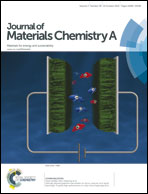Hierarchical ultrathin-branched CdS nanowire arrays with enhanced photocatalytic performance†
Abstract
The controlled chemical conversion of nanomaterials represents an important basis for both understanding the nanoscale chemical activity and exploring new desirable materials. Currently, the region selective ion-exchange transformation of two-dimensional (2D) nanosheets into three-dimensional (3D) nanostructures, especially endowed with both ultrathin features and hierarchical architecture, is highly challenging. Herein, we present a facile chemical transformation strategy to synthesize 3D hierarchical ultrathin-branched CdS nanowire arrays (3DHU-CdS) with an adjustable branch size by the reaction of 2D ZnS–amine inorganic–organic sheets with cadmium ions. The selective cation-exchange induced appearance of CdS nanocrystals on hybrid nanosheets, the following amine-assisted branched seed formation and the subsequent S2− ion self-diffusion dominated growth are found to be important for producing 3DHU-CdS. Benefiting from the unique hierarchical and ultrathin structural features, the as-prepared 3DHU-CdS exhibit enhanced visible-light-driven photocatalytic performance for the water-reduction hydrogen evolution reaction (HER). Additionally, the 3DHU-CdS are found to be promising photosensitizers for constructing noble-metal-free biomimetic artificial hybrid systems. This facile selective cation-exchange induced chemical transformation strategy of inorganic–organic hybrid composites could be extended to the preparation of more complex hierarchical nanostructures which may have potential application in solar energy conversion.


 Please wait while we load your content...
Please wait while we load your content...